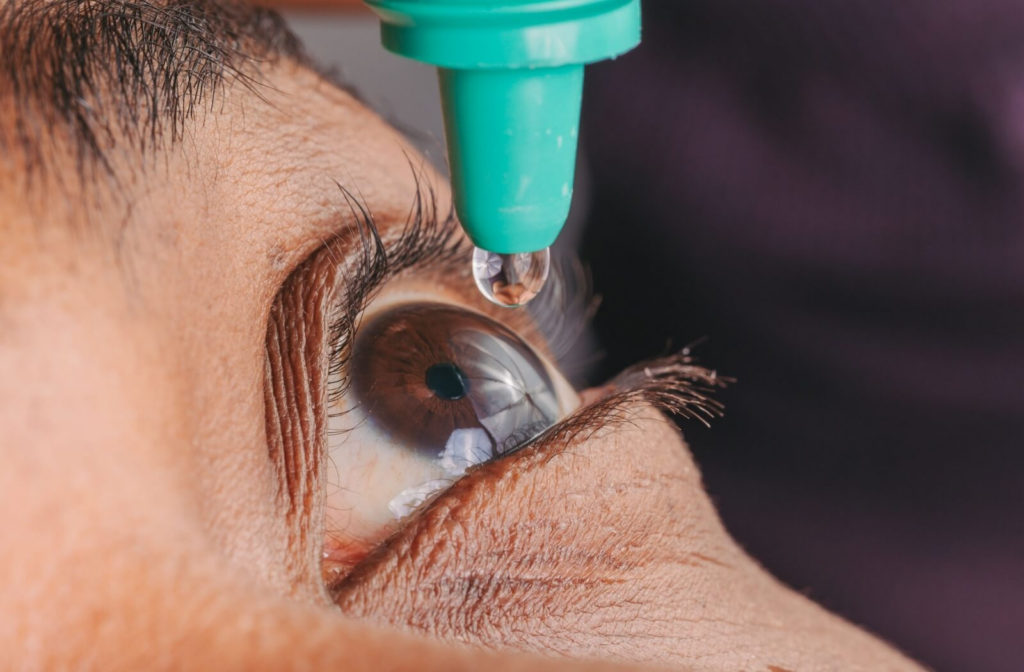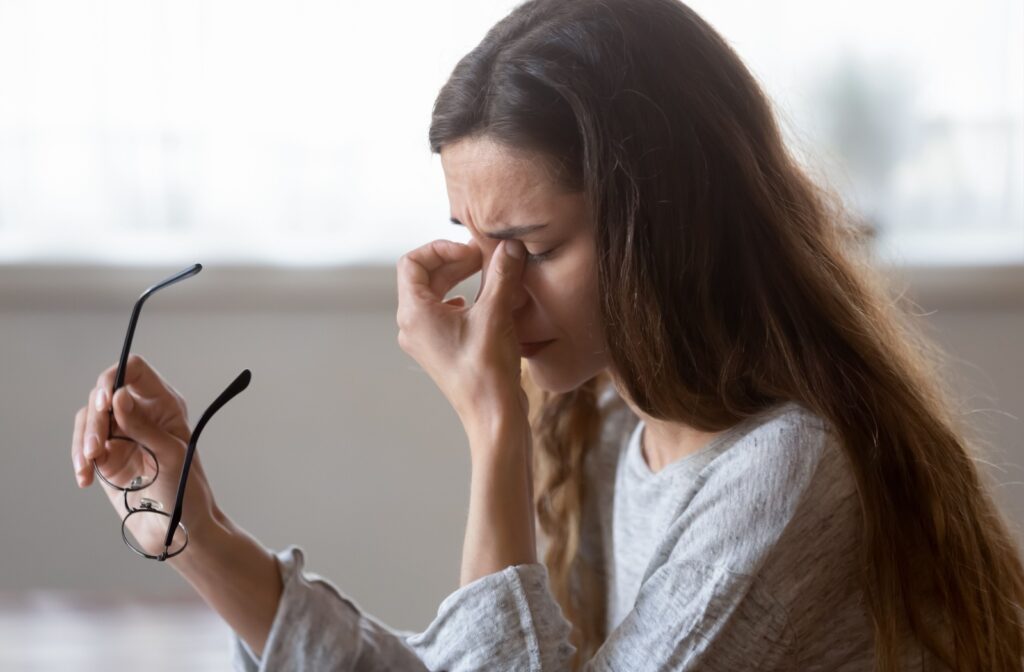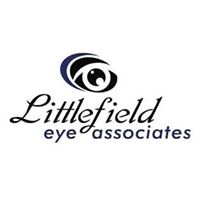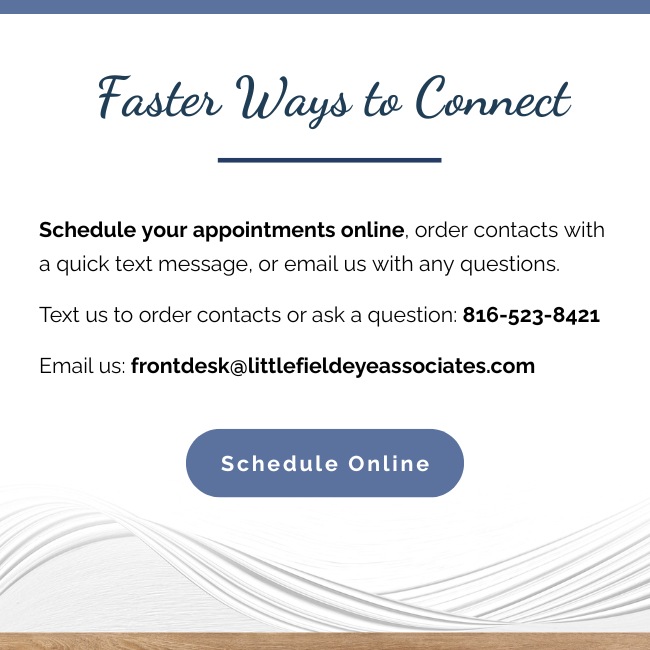Floaters can be surprising when they suddenly drift across your vision—especially if you’re already dealing with the redness, irritation, or watery eyes that often come with dry eye. When both symptoms happen around the same time, it’s easy to assume they’re connected.
Although dry eye and floaters can occur at the same time, there’s no direct link between the two. Understanding the common symptoms of dry eye can help you recognize what’s typical, what’s not, and when it’s time to see your optometrist.
What Is Dry Eye?
Dry eye can occur for several reasons, including screen use, dry air, smoke, allergies, certain medications, aging, or meibomian gland dysfunction (MGD). The two most common types of dry eye are inadequate tear production and the premature evaporation of the tears.
If you’ve experienced the uncomfortable symptoms of dry eye, you know how much it can disrupt your daily life. If you’re dealing with persistent symptoms, visit your eye doctor for a comprehensive evaluation.
Treating Dry Eye
The first step in treating dry eye is identifying the underlying cause. In some cases, over-the-counter lubricating eye drops can offer enough relief. However, more persistent or severe cases may require prescription treatments or in-office procedures. Common Dry Eye Treatments Include:
Lubricating eye drops:
Often the first choice for symptom relief, these drops can also be used alongside other therapies. Preservative-free formulas are typically recommended, as they’re gentler and less likely to cause irritation with frequent use.
Prescription medication:
Depending on your needs, your optometrist may prescribe topical or oral medications. These may help stimulate natural tear production, reduce inflammation, or treat any underlying infection contributing to your symptoms.
Intense Pulsed Light (IPL):
For patients with premature tear evaporation, IPL therapy may help by stimulating the meibomian glands and reducing inflammation around the eyes. This treatment can offer effective, long-term relief for some types of dry eye.
Meibomian gland expression:
Your optometrist may use a warm compress followed by gentle pressure to express clogged oil from the meibomian glands. There are also in-office therapies available that use heat and massage to help restore gland function and improve tear film stability.
Low-Level Light Therapy (LLLT/Red Light Therapy):
An emerging option for treating dry eye is low-level light therapy. This non-invasive treatment uses specific wavelengths of light to gently stimulate cellular activity, improve circulation, and reduce inflammation. It can support healthier meibomian gland function and tear film stability. Beyond dry eye, LLLT is also being used for other eye-related conditions, including styes and blepharitis, with research underway on its potential role in age-related macular degeneration (ARMD).

Complications from Dry Eye
While discomfort is the most common symptom of dry eye, it’s not the only concern. Without proper treatment, dry eye can lead to additional complications, including:
Eye infections
Tears don’t just keep your eyes moist—they also help protect against infection by flushing away germs and debris. If your eyes aren’t producing enough tears or your tear film evaporates too quickly, your risk of developing an eye infection increases.
Damage to the eye’s surface
When your eyes aren’t properly lubricated, blinking and eye movement can cause friction. Over time, this can lead to irritation, surface damage, and even blurred vision.
What Are Floaters?
Floaters are those small black spots, squiggles, or cobweb-like shapes that drift across your vision. They’re usually harmless and part of the natural aging process as the gel-like vitreous in your eye gradually breaks down. For most people, floaters aren’t a major concern—but if you’re already dealing with visual discomfort from dry eyes, they can feel more disruptive.
Is There a Connection Between Dry Eye & Floaters?
Floaters and dry eyes can sometimes appear at the same time, but they don’t share a direct cause. What they do have in common is a key risk factor: age. As we get older, both floaters and dry eye symptoms tend to become more common. That’s why regular eye exams are so important—they can help identify and manage multiple vision changes as you age.
Treating Floaters
In most cases, floaters don’t require treatment unless they significantly interfere with your daily life. If they become disruptive, your eye doctor may recommend a vitrectomy—a surgical procedure that removes the vitreous gel causing the floaters and replaces it with a clear solution to help restore visual clarity.
If you notice new floaters, a sudden increase in floaters, or flashes of light, it’s important to book an eye exam right away—even if your vision seems unaffected. These symptoms could be signs of retinal detachment, a potentially vision-threatening condition that requires prompt treatment.
We’re Here to Help
Floaters and dry eyes may share some symptoms and show up at the same time, but they have different causes—and different treatments. While floaters are usually harmless, they can sometimes signal a more serious issue, especially if they appear suddenly or are accompanied by flashes of light. And dry eye, though common, can lead to complications if left untreated.
If you’re experiencing dry eye, the first step to finding a solution should be a comprehensive eye exam. At Littlefield Eye Associates, our team can help identify what’s causing your symptoms and recommend the right treatment for your comfort and peace of mind. Book your appointment today—we’re here to protect your vision.





